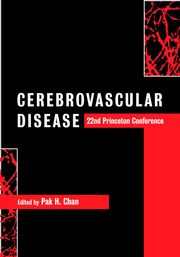Book contents
- Frontmatter
- Contents
- List of contributors
- Preface
- Acknowledgments
- Part I Special lectures
- Part II Oxidative stress
- 3 Peroxynitrite and injury to the vasculature and central nervous system in stroke and neurodegeneration
- 4 Interaction between inducible nitric oxide and cyclooxygenase-2 in ischemic brain injury
- 5 Mechanisms of ischemic tolerance
- 6 Clinically tolerated NMDA receptor antagonists and newly cloned NMDA receptor subunits that mimic them
- Part III Apoptosis
- Part IV Hot topics
- Part V Hemorrhage, edema and secondary injury
- Part VI Inflammation
- Part VII Gene transfer and therapy
- Part VIII Neurogenesis and plasticity
- Part IX Magnetic resonance imaging in clinical stroke
- Part X Risk factors, clinical trials and new therapeutic horizons
- Index
- Plate section
6 - Clinically tolerated NMDA receptor antagonists and newly cloned NMDA receptor subunits that mimic them
from Part II - Oxidative stress
Published online by Cambridge University Press: 02 November 2009
- Frontmatter
- Contents
- List of contributors
- Preface
- Acknowledgments
- Part I Special lectures
- Part II Oxidative stress
- 3 Peroxynitrite and injury to the vasculature and central nervous system in stroke and neurodegeneration
- 4 Interaction between inducible nitric oxide and cyclooxygenase-2 in ischemic brain injury
- 5 Mechanisms of ischemic tolerance
- 6 Clinically tolerated NMDA receptor antagonists and newly cloned NMDA receptor subunits that mimic them
- Part III Apoptosis
- Part IV Hot topics
- Part V Hemorrhage, edema and secondary injury
- Part VI Inflammation
- Part VII Gene transfer and therapy
- Part VIII Neurogenesis and plasticity
- Part IX Magnetic resonance imaging in clinical stroke
- Part X Risk factors, clinical trials and new therapeutic horizons
- Index
- Plate section
Summary
Excitotoxic and free radical injury to cerebrocortical neurons
In recent years, excitotoxic (glutamate-related) and free radical-mediated injury/cell death of neurons has been recognized as an important final common pathway in a variety of neurological diseases, ranging from acute ischemic stroke and trauma, to chronic neurodegenerative conditions such as Huntington's disease, amyotrophic lateral sclerosis, Alzheimer's disease and human immunodeficiency virus-associated dementia. Many laboratories, including our own, have shown that neuronal cell death in these maladies is all due at least in part to the excitotoxic and free radical nature of the insult. We have further demonstrated that fulminant insults with glutamate and free radicals lead to severe energy depletion with resultant loss of ionic homeostasis. This produces swelling and cell lysis or necrosis. Conversely, more mild insults produce only transient energy loss and result in neuronal apoptosis. Moreover, the existence of a final common pathway for neuronal damage means that a similar therapeutic approach may possibly be effective for each of these varied insults.
Therapeutic approaches to preventing cerebrocortical neuron injury: glutamate receptor antagonists
A major type of glutamate receptor-mediated cerebrocortical neuron injury is due to overstimulation of the N-methyl-d-aspartate (NMDA) subtype of receptor. Although other glutamate receptors can contribute to excitotoxicity, the NMDA receptor is particularly important because of its extreme permeability to Ca2+, which in excess can overload mitochondria and lead to excessive enzyme activity and free radical formation.
- Type
- Chapter
- Information
- Cerebrovascular Disease22nd Princeton Conference, pp. 72 - 78Publisher: Cambridge University PressPrint publication year: 2002



